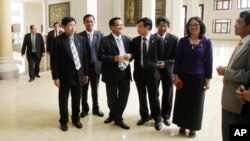The number of qualified female candidates able to run in the forthcoming commune elections in June remains low, politicians from both sides of the aisle have said.
Sok Eysan, a ruling Cambodian People’s Party spokesman, said in the last local election one in five ruling party candidates were women, adding that the party is taking steps to increase female political participation.
“We try to [have] as many women as possible, but we need to ensure their qualifications too,” he said.
Mu Sochua, the deputy president of the opposition Cambodia National Rescue Party, said the party had doubled the number of women candidates it could field compared with the 2012 elections.
She said that, unlike their male counterparts, Cambodian women still find themselves bound to the home and family life.
“Our women candidates are supposed to clearly understand the situation of the local area, have good communication and be a knowledgeable person,” she said.
“Women in leading positions could better help women who are the victims of domestic violence and solve the problems that women are facing.”
Sam Inn, a representative of the newly established Grassroots Democracy Party, said a quarter of the party’s 400 candidates would be women.
“We could only have 25 percent female candidates. We couldn’t make it up to 50% yet as the number of outstanding women candidates is still limited.”
Seng Reasey, a women’s rights worker at local NGO Silaka, said that despite women making up roughly half the population, they remain under-represented in decision-making processes.
“Only 17 percent of women are represented at the sub-national level and 20 percent at national level,” she said.
She dismissed claims that women are not qualified for the jobs.
“Have they ever seen the responsibility women have? Have they ever given enough opportunities to women? Have they ever created a situation for women to take the lead?”








